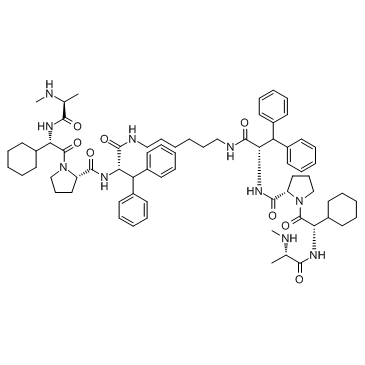| Reference | 1. J Thorac Oncol. 2011 Nov;6(11):1801-9. doi: 10.1097/JTO.0b013e318226b4a6.
<br>
BV6, an IAP antagonist, activates apoptosis and enhances radiosensitization of
non-small cell lung carcinoma in vitro.
<br>
Li W(1), Li B, Giacalone NJ, Torossian A, Sun Y, Niu K, Lin-Tsai O, Lu B.
<br>
Author information: <br>
(1)Department of Radiation Oncology, Vanderbilt-Ingram Cancer Center, Vanderbilt
University School of Medicine, Nashville, Tennessee, USA.
<br>
INTRODUCTION: Defects in the apoptosis pathway limit the effectiveness of
radiation in non-small cell lung cancer (NSCLC) therapy. BV6 is an antagonist of
cIAP1 and XIAP, members of the inhibitors of apoptosis (IAP) family. We
investigated the potential of BV6 to sensitize NSCLC cell lines to radiation.
METHODS: HCC193 and H460 lung cancer cell lines were treated with BV6 to
investigate the effects of drug administration on cell proliferation, apoptosis,
inhibition of XIAP and cIAP1, and radiosensitivity. Subsequent immunoblotting and
Hoechst staining were used to determine the role of apoptosis in
radiosensitization. Finally, the pathway of apoptosis was characterized by
Western blot analysis for cleaved caspase-8 and cleaved caspase-9 and
enzyme-linked immunosorbent assays for TNF-α.
RESULTS: HCC193 was found to be more sensitive than H460 to BV6-induced apoptosis
in a concentration-dependent and time-dependent manner. BV6 significantly
sensitized both cell lines to radiation (HCC193-DER = 1.38, p < 0.05 at 1 μM BV6;
H460-DER = 1.42, p < 0.05 at 5 μM BV6), but a higher concentration of and longer
incubation time with BV6 was necessary for H460 cells. The BV6-induced
radiosensitization of HCC193 favored the extrinsic pathway of apoptosis, whereas
that of H460 favored the intrinsic pathway.
CONCLUSIONS: BV6, an IAP antagonist, significantly enhanced the
radiosensitization of HCC193 and H460 cells in vitro. More research is warranted
to test the mechanism of action of BV6 and to assess its potential in vivo and in
the clinical setting.
<br>
2. Scand J Immunol. 2000 Jun;51(6):543-7.
<br>
Human T-cell receptor BV6 gene polymorphism in relation to expression level and
CD4/CD8 skewness.
<br>
Obata F(1), Shiiba R, Iizuka M, Kashiwagi N, Kurosu F, Shimada N, Nishijima M,
Tozawa H.
<br>
Author information: <br>
(1)Department of Immunology, Kitasato University School of Allied Health
Sciences, Sagamihara, Kanagawa, Japan.
<br>
Using 50 samples of umbilical cord blood lymphocytes from Japanese donors, we
analysed two human T-cell receptor beta variable (TCRBV) genes, BV6S4 and BV6S5,
for their polymorphism, usage frequencies and CD4/CD8 skewness. They showed
contrasting CD4/CD8 skewness, BV6S4 to CD8+ T cells and BV6S5 to CD4+ T cells.
Genotyping of the BV6S4 alleles (A1, A2 and A3) revealed two of the six possible
BV6S4 genotypes, A1/A2 and A2/A2. Among the two BV6S4 genotypes, no significant
difference was detected in usage frequency or CD4/CD8 skewness. On the other
hand, genotyping of the BV6S5 alleles (A1 and A2) revealed all three possible
BV6S5 genotypes, A1/A1, A1/A2 and A2/A2, and the gene usage frequency was high,
in the order A1/A1 > A1/A2 > A2/A2. These results indicate that the amino acid
substitutions in BV6S5 (S36R and G70E) are in some way associated with the
expression level of this gene. In the analysis of CD4/CD8 skewness, the three
BV6S5 genotypes had similar skewness, indicating that A1 alleles are expressed
more frequently than A2 alleles in both CD4+ and CD8+ T-cell populations.
Although BV6S5 exhibits marked skewness to CD4+ T cells, our results indicate
that the higher expression of A1 alleles is not associated with the increased
ratio of CD4+ T cells.
<br>
|

